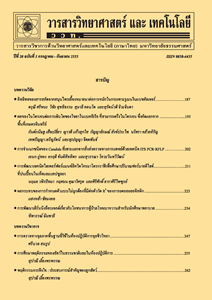การใช้ตัวแบบการกำหนดราคาสินทรัพย์เพื่อเปรียบเทียบอัตราผลตอบแทนและความเสี่ยงของการลงทุนในตลาดหลักทรัพย์แห่งประเทศไทย หมวดธนาคาร
Main Article Content
Abstract
Abstract
The objectives of this paper are to study and compare the return-risk in bank sector and securities from the stock exchange of Thailand including evaluating the securities value in bank sector whether the yielding return is higher than the market (overvalued) or lower than the market (undervalued) for investment decision making. Data were collected using a total of 11 trading securities in bank sector from the stock exchange of Thailand. Using monthly close prices to calculate rate of return, 3-month treasury-bill rate as a proxy for risk free rate and using the data of SET index to calculate market rate of return. For each security, 60 monthly data were collected starting from February 2013 to January 2018 and then parameters were estimated by linear regression equation based on capital asset pricing model (CAPM). The results from descriptive statistics show that the average monthly market rate of return is 0.418 %, the highest value is 6.865 %, the lowest value is -9.053 % and standard deviation is 3.479 %. Average monthly rate of return 3-month treasury-bill or risk free rate is 0.148 % and standard deviation is 0.482 %. The results show that 7 securities (BAY, KBANK, KKP, LHBANK, TCAP, TISCO and TMB) give the average monthly rate of return more than the market rate of returns, 4 securities (BBL, CIMBT, KTB and SCB) give the average monthly rate of return less than market rate of return. The highest security average monthly rate of return is KKP (1.131 %) and the lowest security average monthly rate of return is CIMBT
(-1.127 %). Risk analysis shows that 7 securities (BAY, CIMBT, KBANK, KKP, KTB, SCB and TISCO) have systematic risk (Beta) more than the market and move in the same direction as the market. On the other hand, 4 securities (BBL, LHBANK, TCAP and TMB) have systematic risk (Beta) less than the market and move in the opposite direction as the market. Finally, securities valuation shows that the 6 securities that should be invested are BAY, KKP, LHBANK, TCAP, TISCO and TMB because they are undervalued. In contrast, 5 securities that should not be invested are BBL, CIMBT, KBANK, KTB and SCB because they are overvalued.
Keywords: close price; systematics risk; excess return; risk premium; linear regression
Article Details
References
[2] ดวงฤดี วงศ์จรัสเกษม, 2554, การวิเคราะห์อัตราผลตอบแทนและความเสี่ยงของการลงทุนในตลาดหลักทรัพย์แห่งประเทศไทย หมวดวัสดุก่อสร้าง, การศึกษาค้นคว้าด้วยตนเองตามหลักสูตรบริหารธุรกิจมหาบัณฑิต สาขาวิชาการเงิน, บัณฑิตวิทยาลัย มหาวิทยาลัยหอการค้าไทย, กรุงเทพฯ, 98 น.
[3] Brigham, E.F. and Ehrhardt, M.C., 2005, Financial Management Theory and Practice, 11th ed., Thomsom/South-Western, Mason.
[4] ตลาดหลักทรัพย์แห่งประเทศไทย, มูลค่าการซื้อขายหลักทรัพย์หมวดธนาคารในตลาดหลักทรัพย์แห่งประเทศไทย, แหล่งที่มา : http://www.setsmart.com, 15 กุมภาพันธ์ 2561.
[5] ธนาคารแห่งประเทศไทย, อัตราผลตอบแทนตั๋วเงินคลังและพันธบัตรรัฐบาล, แหล่งที่มา : http://www2.bot.or.th/statistics/ReportPage.aspx?reportID=223, 16 กุมภาพันธ์ 2561.
[6] เปรมประภา สุทธิประภา และกาญจนา เศรษฐนันท์, 2558, การวิเคราะห์ผลตอบแทนและความเสี่ยงการประเมินราคาหุ้นและการจัดพอร์ตการลงทุนในหุ้นกลุ่มธนาคารพาณิชย์ โดยวิธี Capital Asset Pricing Model, น. 1674-1678, ใน การประชุมวิชาการทางธุรกิจและนวัตกรรมทางการจัดการระดับชาติและนานา ชาติ ประจำปี 2558, วิทยาลัยบัณฑิตศึกษาการจัดการ มหาวิทยาลัยขอนแก่น, ขอนแก่น.
[7] Pamane, K. and Vikpossi, A.E., 2014, An analysis of the relationship between risk and expected return in the BRVM stock exchange: Test of the CAPM, RWE 5: 13-28.
[8] ดนัย ปัตตพงศ์, Capital asset pricing model (CAPM), แหล่งที่มา : http://it.nation.ac.th/faculty/danai/download/mbamadeeasy73.pdf, 22 กุมภาพันธ์ 2561.


